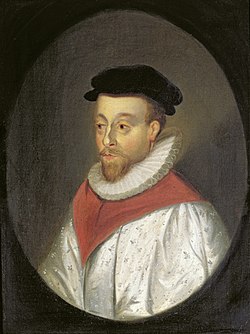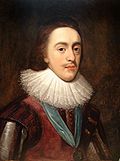Orlando Gibbons
Orlando Gibbons (born: Oxford, baptised 25 December 1583; died Canterbury, 5 June 1625) was an English composer and organist. He was one of the most important composers of his day. He is famous for his church music and organ music. He lived in the late Tudor and early Jacobean periods.
Orlando Gibbons | |
|---|---|
 Orlando Gibbons | |
| Born | December 25, 1583 |
| Died | June 5, 1625 (aged 41) |
| Occupation | Musician, composer |
Gibbons was born in Oxford where his father was a city wait. The family moved to Cambridge and his brother Edward, who was 15 years older than Orlando, became Master of the Choristers at King’s College. Between 1596 and 1598 Orlando sang in the choir of King's College, Cambridge where his brother was master. He entered the university in 1598 and got the degree of Bachelor of Music in 1606. He married and had seven children.
James I made him a Gentleman of the Chapel Royal, where he was organist from at least 1615 until his death. In 1625 he became senior organist at the Chapel Royal, with Thomas Tomkins as junior organist. He was also keyboard player (mainly harpsichord) in the privy chamber of the court of Prince Charles (later King Charles I), and organist at Westminster Abbey. He died an early death in Canterbury of apoplexy, and a monument to him was built in Canterbury Cathedral.
Gibbons wrote a lot of keyboard works, around thirty fantasias for viols, some madrigals (the best-known being The Silver Swan), and many popular anthems. He was very good at writing counterpoint as well as lovely melodies. His famous verse anthem This is the record of John is often sung by choirs at Advent. It has a lovely solo for a countertenor who takes it in turns with the full chorus. Gibbons wrote two settings of the Evensong service: a long one with several verses, and the Short service. His full anthems include O Lord in thy wrath, and the Palm Sunday setting of O clap your hands together for 8 voices.
Orlando Gibbons Media
James Sargant Storer's drawing of, Orlando Gibbons's baptism place, St Martin's Church, Oxford, dated sometime before its renovations in 1820
16th-century Cambridge (Map by Braun and Hogenberg)
Portrait of Charles, employer of Gibbons, as Prince of Wales after Daniel Mytens, c. 1623
Gibbons' memorial in Canterbury Cathedral designed by Nicholas Stone.
Bust of Gibbons in Westminster Abbey, London
References
- ↑ Harley 1999, p. 29.





